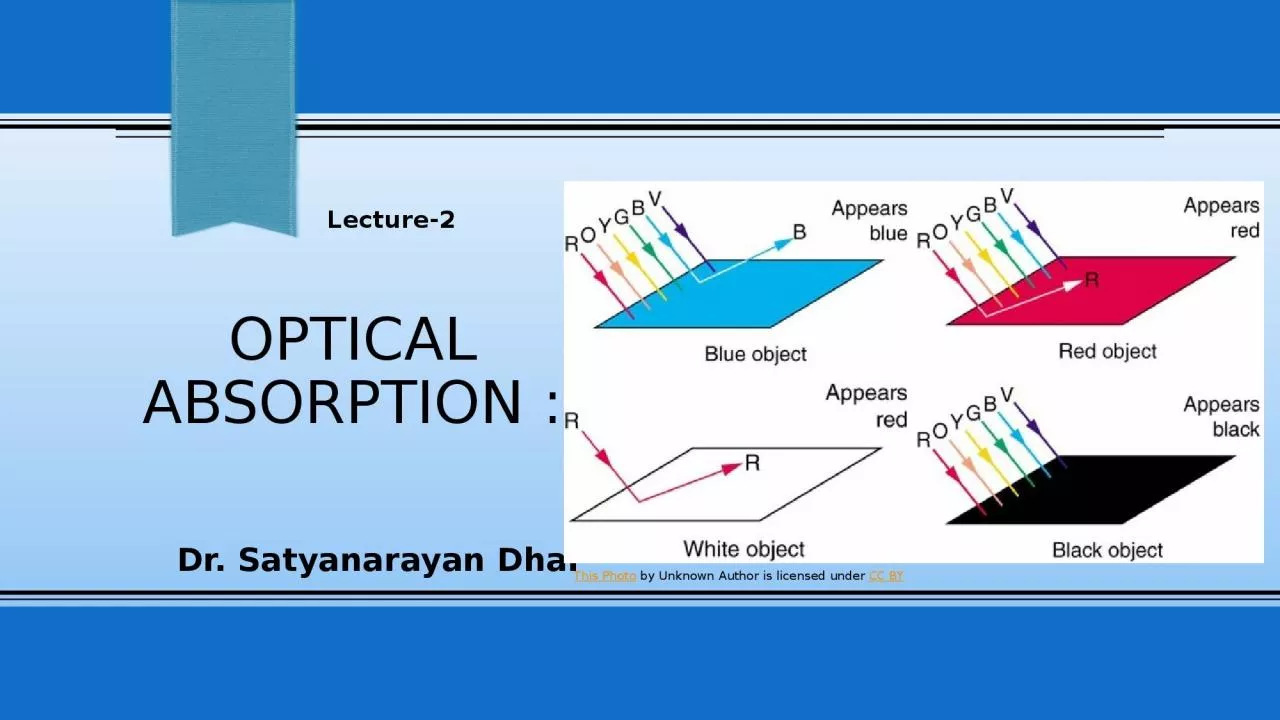

Lecture2 This Photo by Unknown Author is licensed under CC BY 2 What is Optical Absorption Definition This is the phenomena when any material object takes up the light energy photon and alters electromagnetic energy into heat energy of the absorber ID: 1032259
Download Presentation The PPT/PDF document "Optical absorption : Dr. Satyanarayan Dh..." is the property of its rightful owner. Permission is granted to download and print the materials on this web site for personal, non-commercial use only, and to display it on your personal computer provided you do not modify the materials and that you retain all copyright notices contained in the materials. By downloading content from our website, you accept the terms of this agreement.
1. Optical absorption :Dr. Satyanarayan DhalLecture-2This Photo by Unknown Author is licensed under CC BY
2. — 2What is Optical Absorption?Definition : This is the phenomena when any material object takes up the light energy (photon) and alters electromagnetic energy into heat energy of the absorber.Linear absorption : When the absorption of waves does not depend on their intensity.Nonlinear absorption : Sometimes the medium's transparency changes by a factor that varies as a function of wave intensity, and nonlinear absorption occurs. This Photo by Unknown Author is licensed under CC BY-SA
3. How to measure radiation absorption ??3The absorbance of an object : How much of the incident light is absorbed by it (instead of being reflected or refracted). What we will know by knowing absorbance ?Ans : Identification of a substance via absorption spectroscopy Attenuation : Reduction of the intensity of light waves as they propagate through a medium. This Photo by Unknown Author is licensed under CC BY-SA
4. How to measure radiation absorption ??4In absorption spectroscopy, a sample is irradiated from one side, and the light that exits from the sample in every direction is measured. This Photo by Unknown Author is licensed under CC BY-SA
5. Beer–Lambert law5relates the attenuation of light to the properties of the material through which the light is travelling.Applied to chemical analysis measurements used in understanding attenuation in physical optics, for photons, neutrons, or rarefied gases. l is the optical path length (product of the geometric length of the path followed by light through a given system, and the refractive index of the medium through which it propagates.)c is the concentration of the attenuating species is is the molar attenuation coefficient or absorptivity of the attenuating species. (It indicates how strongly a chemical species attenuates light at a given wavelength.)Unit : (m2/mol), ; attenuation coefficient is also called as the molar extinction coefficient and molar absorptivity. is the optical path length
6. Ultraviolet–visible spectroscopy ( 6Molecules containing bonding and non-bonding electrons absorb energy in the form of UV or visible light.They excite these electrons to higher anti-bonding molecular orbitals.The energy gap between the HOMO and the LUMO is lower, then the wavelength of light absorbed will be longer.4 possible types of transitions : σ–σ* > n–σ* > π–π* > n–π* is the optical path lengthIn this region of the electromagnetic spectrum, atoms and molecules undergo electronic transitions. This Photo by Unknown Author is licensed under CC BY-SA
7. UV/Vis spectrophotometer7It measures the intensity of light after passing through a sample.It compares it to the intensity of light before it passes through the sample.Transmittance : is the ratio expressed as a percentage (%T). Absorbance (A) = -(log(%T/100%)The UV–visible spectrophotometer can also be designed to determine reflectance; where the spectrophotometer determines the intensity of light reflected from a sample , and compares it to the intensity of light reflected from a reference material. is the optical path lengthThis Photo by Unknown Author is licensed under CC BY-SA
8. How UV/Vis spectrophotometer works ?8 is the optical path lengthThis Photo by Unknown Author is licensed under CC BY-SA-NC
9. Band Gap is a very important property for PV Solar Cells !9 is the optical path lengthThis Photo by Unknown Author is licensed under CC BY-SAThis Photo by Unknown Author is licensed under CC BY-SA
10. Efficiency of PV Cell (Shockley–Queisser limit)10 is the optical path lengthMaximum theoretical efficiency of a PV using a single p-n junction to gather power from the cell.The limit is around 33.7% for a single p-n junction PV cell.The corresponding band gap of 1.34 eV.Why silicon ?Si has a less favorable band gap of 1.1 eV, resulting in a maximum efficiency of about 32%.
11. How we can calculate band gap from UV-Vis Spectroscopy ?11Reference : Kumar, H., & Rani, R. (2013). Structural and optical characterization of ZnO nanoparticles synthesized by microemulsion route. International Letters of Chemistry, Physics and Astronomy, 14, 26-36.Tauc plot shows the quantity hν (the energy of the light) on the abscissa and the quantity (αhν)1/r on the ordinate, where α is the absorption coefficient of the material.Band Gap of ZnO NP = 3.7 eV
12. Other Few Examples12Ultraviolet–visible spectroscopy, Infrared spectroscopy, X-ray absorption spectroscopy.This Photo by Unknown Author is licensed under CC BY-SAThis Photo by Unknown Author is licensed under CC BY-NC
13. Applications of Absorption Spectroscopy13